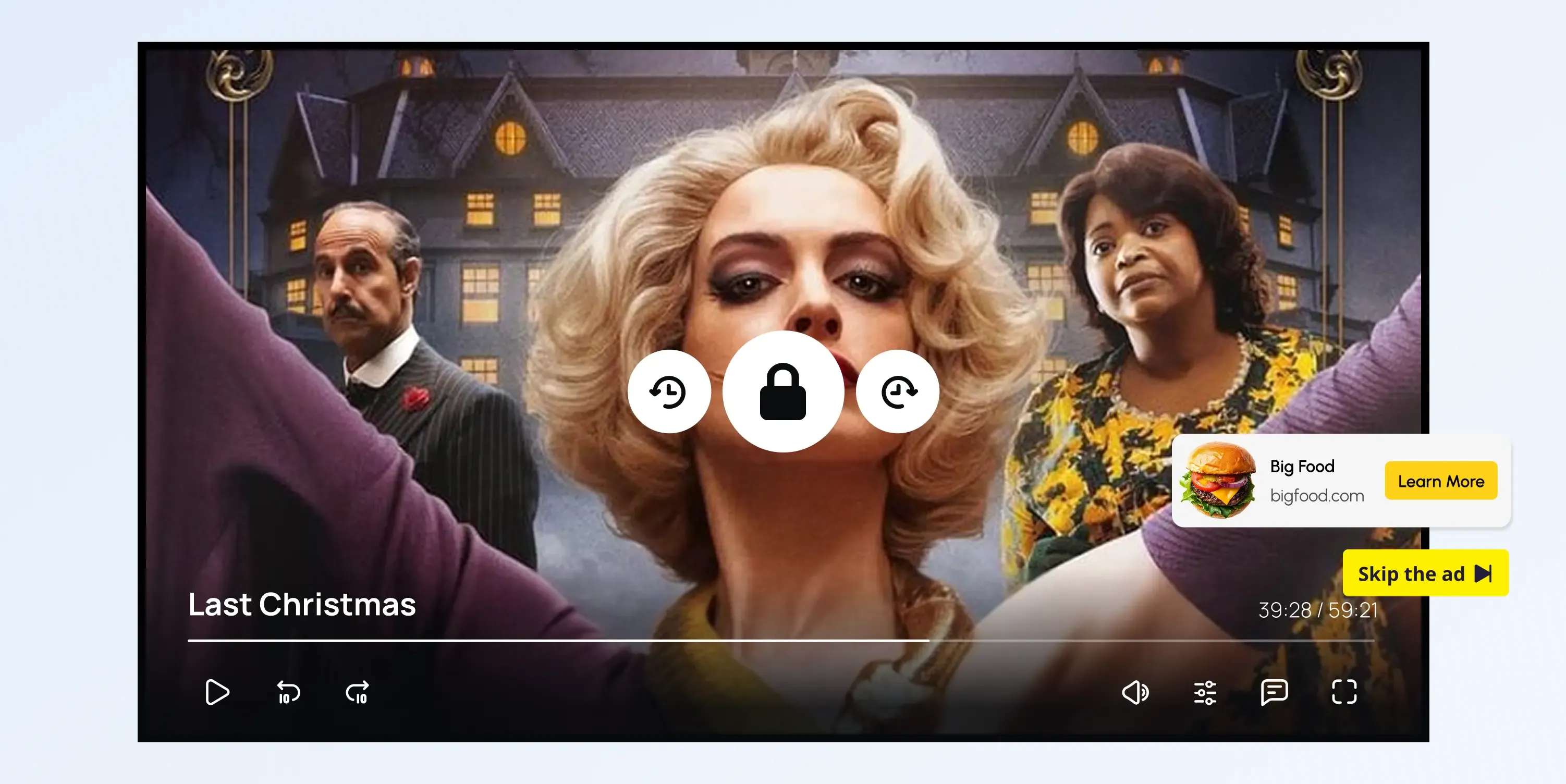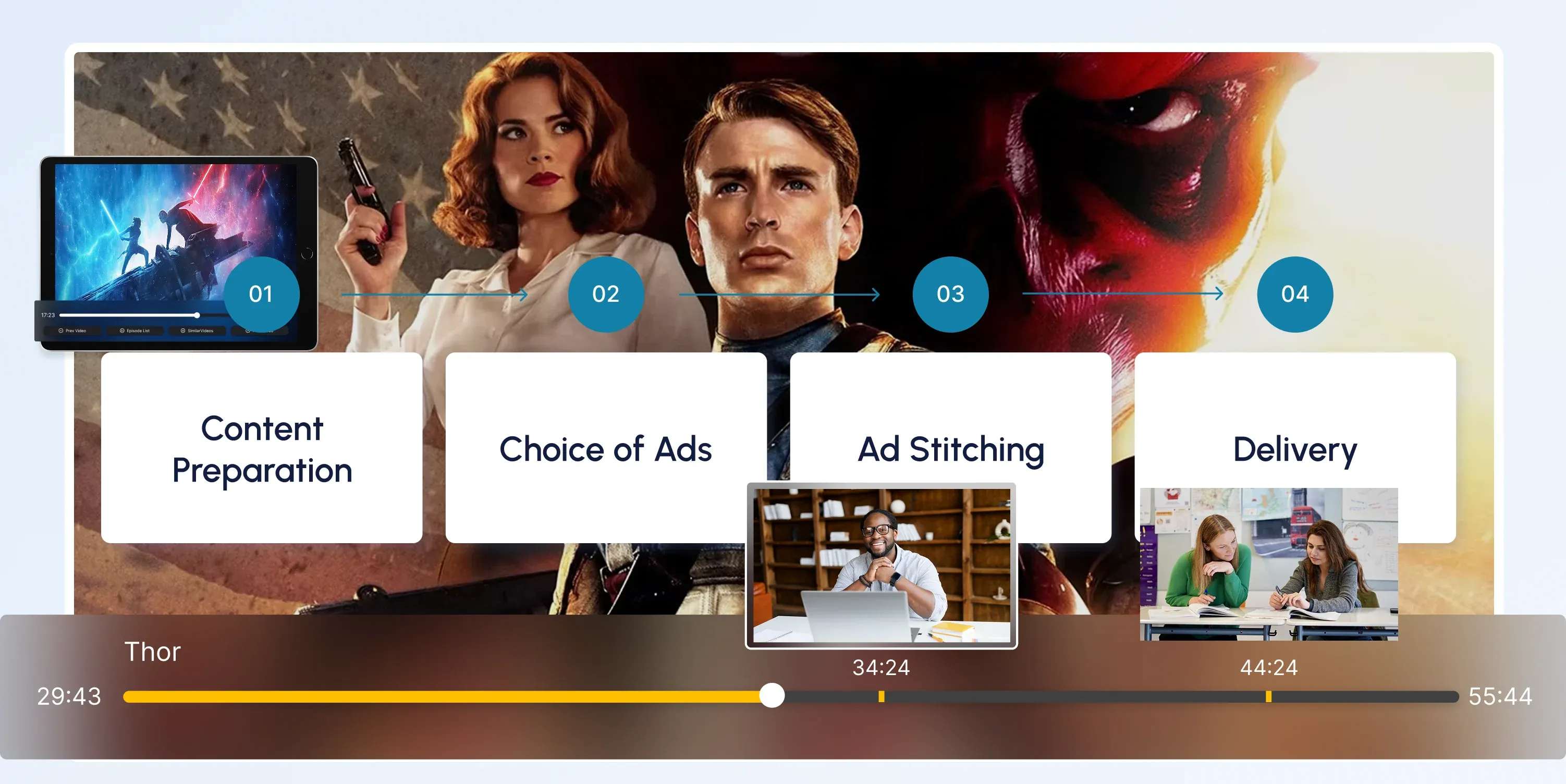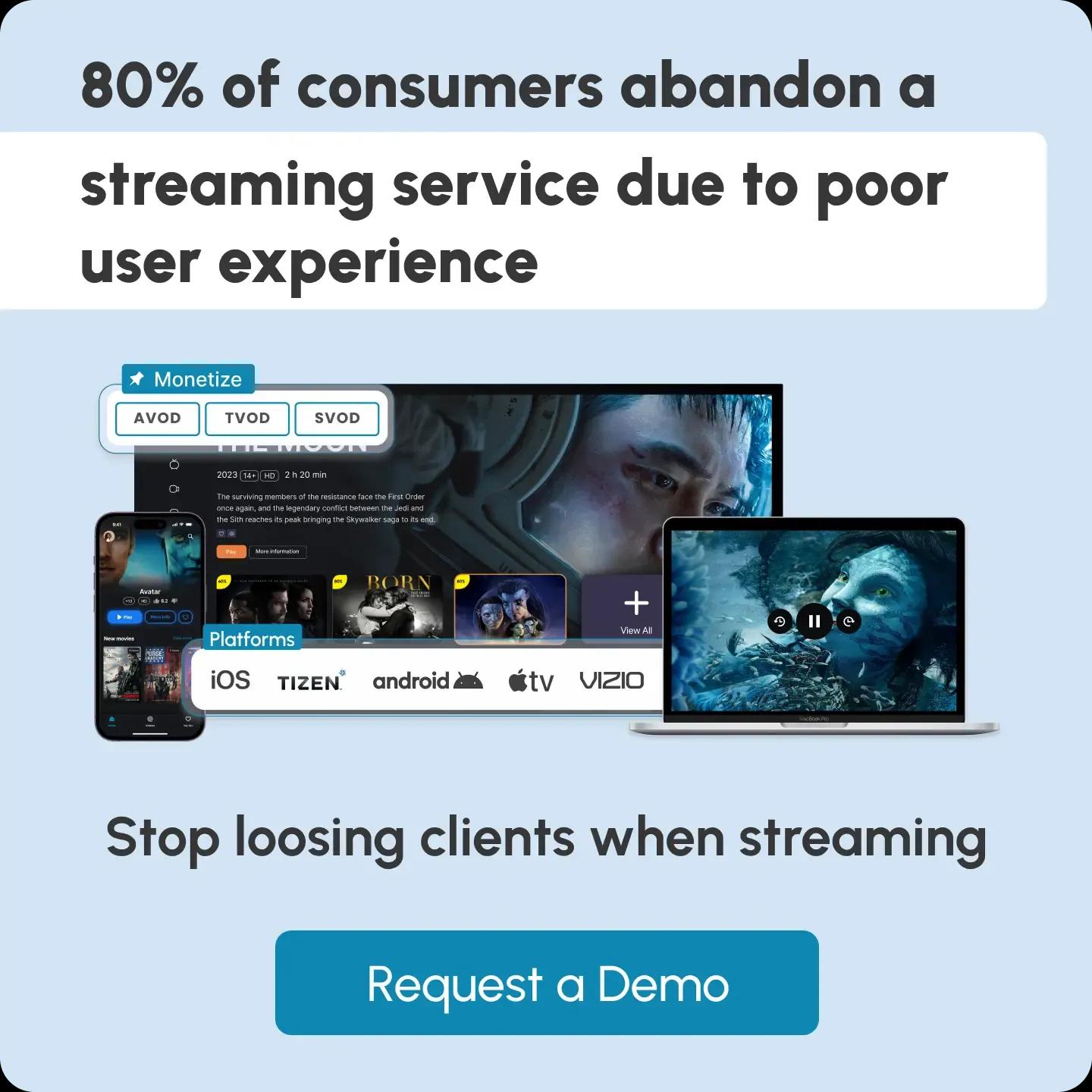Glossary term
Dynamic Ad Insertion (DAI)

What Is DAI?
Dynamic Ad Insertion (DAI) is the process of inserting or replacing ads within a video or audio stream in real time, based on data about the viewer, such as demographics, location, device, or behavior.
DAI isn’t a separate technology on its own, but rather an approach that can be implemented using SSAI (server-side ad insertion) or CSAI (client-side ad insertion). The “dynamic” part refers to the ad decisioning engine that selects the most relevant ad for each viewer at the moment of playback.
DAI = personalized, real-time ad targeting + delivery, regardless of whether the ads are stitched server-side or loaded client-side.
How Does Dynamic Ad Insertion Work?
To start the dynamic ad insertion, a viewer has to request a video stream (like a live broadcast, a replay, or on-demand content). Before playback begins, the platform checks the user’s profile data. This data might include location, device type, time of day, past viewing behavior, or demographic details.
The purpose is to decide which ad would be most relevant for this specific viewer.
Once the request is made, the video player or streaming server contacts an ad decisioning system (such as an ad server or SSP(Supply-Side Platform)). This system runs in real time, matching the viewer’s profile against available ads in the inventory.
Example:
A sports fan watching a football match on their mobile phone in New York might be served an athletic wear ad, while someone else watching the same stream in Los Angeles could see a food delivery ad.
The chosen ads are then inserted into the content stream using one of two methods: SSAI or CSAI (more about these later on).
If the platform uses SSAI (server-side ad insertion), the ads are stitched directly into the video before delivery, making them look like part of the show. This provides seamless and fast playback, but limits advertisers’ ability to track important metrics like progress, click-through rates, interactions, and errors.
If it uses CSAI (client-side ad insertion), the ads are fetched separately by the player and displayed at the correct break points. In both cases, the insertion occurs seamlessly, allowing the viewer to experience smooth playback.
Learn more about SSAI and CSAI.
Next, tracking and analytics are applied. Every ad impression, completion rate, or click is reported back to the advertiser. This way, advertisers know who saw their ad and how it performed, while publishers maximize revenue by delivering the right ads to the right people.
Technical Components in DAI
Depending on which method is used (SSAI or CSAI), dynamic ad insertion includes this technical component:
1. Ad Podding
Instead of just inserting one ad, platforms can insert a sequence (pod) of multiple ads back-to-back, like a commercial break on TV. The pod can include ads of different lengths and from different advertisers, stitched together dynamically.
2. Ad Stitching
This is the SSAI technique, where ads are merged with the content stream to create a single continuous video feed. It eliminates buffering between ads and content, makes ads resistant to blockers, and ensures a smooth user experience.
3. Manifest Manipulation
For adaptive bitrate streaming protocols like HLS or MPEG-DASH, the manifest (playlist) is dynamically updated to include ad segments at specific markers. This allows precise placement of ads in both live and on-demand streams without breaking the playback continuity.
Server-Side vs Client-Side Ad Insertion in DAI
Since DAI is more of a strategy than a single technology, it combines targeting logic with SSAI or CSAI.
It isn’t about where the ad is inserted (client or server), but how the ad is chosen. DAI adds real-time decisioning and personalization to ensure that ads are dynamically selected for each viewer at the moment of playback.
Here are some real-life examples of DAI:
- Spotify (Audio + Video ads) - Inserts dynamic ads into podcasts and free-tier streams in real time, personalized per listener.
- Paramount+ (formerly CBS All Access) - Uses DAI for both live sports and VOD, swapping ads in real time based on user profile.
- ESPN+ - Dynamic ad targeting in live events, where different users watching the same match may see different ads (based on personalization).
Now let’s take a look at SSAI and CSAI separately.
CSAI
Client-Side Ad Insertion (CSAI) was the early standard for digital video ads. Here, the video player itself requests ads from an ad server and plays them at specific markers. This allows interactivity (clickable ads, skip buttons) and detailed tracking, but it exposes ads to blockers and risks buffering if the ad fails to load.
Examples:
YouTube – Classic CSAI example. Ads are requested by the player (pre-roll, mid-roll, post-roll, overlays). Viewers can click, skip, or engage.
Twitch – Uses CSAI for pre-roll and mid-roll ads in livestreams, allowing interactive ads and detailed analytics for advertisers.
Facebook Watch – Client-side ads are delivered and tracked per user session with interactivity.
SSAI
Server-Side Ad Insertion (SSAI) evolved as a way to improve the user experience. Instead of asking the player to load ads separately, the server stitches ads into the video before delivery. Viewers see one seamless stream, making ads harder to block. The trade-off is reduced interactivity and less granular tracking.
Examples:
Hulu (AVOD version) – Uses SSAI to stitch ads into both live and on-demand content, creating a smooth viewing experience without buffering.
Peacock (NBCUniversal) – Leverages SSAI for live sports and linear channels so ads feel like part of the broadcast.
Disney+ Hotstar (India) – Implements SSAI in live cricket matches to prevent ad-blockers from skipping ads during streams.
All Three Together in Practice
For example, imagine 1 million people watching a live football match:
- With CSAI, the player loads ads individually, and everyone may see the same sponsor’s ad.
- With SSAI, the server stitches ads directly into the stream, ensuring seamless playback but still with uniform ads.
- With DAI, each viewer could see a different ad (sports gear, food delivery, travel deals) depending on their profile — even though they’re all watching the same stream.
Here is a comparison table to finalize SSAI vs CSAI in DAI:
| Feature | SSAI (Server-Side Ad Insertion) | CSAI (Client-Side Ad Insertion) | DAI (Dynamic Ad Insertion) |
|---|---|---|---|
| Where Ads Are Inserted | On the server, stitched into the video stream | On the client device, requested by the video player | Either server or client, depending on the implementation |
| Playback Experience | Seamless, ads appear as part of the stream | Separate ad loading, possible buffering between ads and content | Personalized and dynamic, depending on the SSAI or CSAI setup |
| Ad Blocker Resistance | High (ads are indistinguishable from content) | Low (ads can be blocked/skipped by blockers) | Medium to High (depends on whether server- or client-side) |
| Interactivity | Low (ads behave like content, harder to click/engage) | High (supports clickable, interactive ads) | High potential if CSAI-based, lower if SSAI-based |
| Analytics and Tracking | Limited (harder to track impressions/clicks precisely) | Rich analytics (impressions, clicks, engagement data) | Rich personalization + targeting with analytics |
| Complexity and Cost | Higher (requires server infrastructure for stitching) | Lower (lighter infrastructure, handled on client) | Higher (needs ad decisioning + integration logic) |
| Best For | OTT services, broadcasters, live streaming, where seamlessness matters | Platforms prioritizing interactivity, targeting, and detailed measurement | Publishers/advertisers who want personalized, real-time ad delivery across VOD and live |
DAI vs Traditional Ad Insertion
To picture the difference between traditional ad insertion and DAI, let’s first explain what traditional ad insertion is.
Traditional ad insertion refers to the older way ads were delivered in television and early digital video, before SSAI, CSAI, or DAI became standard.
So, ads were scheduled and placed in fixed slots within the content, the same way commercials run on linear TV. Every viewer saw the same ad at the same point, regardless of who they were, what device they were using, where they were located, or what they wanted to see.
On early video platforms, ad slots were often “hard-coded” into the stream or broadcast, so there was no room for personalization, targeting, or real-time decisioning. Some of us still remember, in a live TV broadcast, a two-minute break would always contain the same commercials for everyone tuned in.
At last, the main difference between these two techniques is personalization.
Traditional ad insertion has this approach, where “everyone gets the same ad, at the same time, in fixed slots”.
Dynamic ad insertion (DAI) delivers personalized and targeted ads in real time.
Comparison Table: DAI vs Traditional Ad Insertion
| Feature | Traditional Ad Insertion | Dynamic Ad Insertion (DAI) |
|---|---|---|
| Ad Placement | Fixed, pre-scheduled ad slots | Ads inserted or replaced in real time |
| Personalization | None. Every viewer sees the same ad | High. Ads tailored to each viewer’s profile (location, behavior, device, etc.) |
| Flexibility | Rigid, changing ads require re-editing or re-encoding | Very flexible, ads can be swapped instantly based on audience or campaign |
| Delivery Method | Linear broadcast style; same stream for all | Works with SSAI (stitched server-side) or CSAI (loaded client-side) |
| Viewer Experience | Uniform, like traditional TV | Individualized: Two people watching the same stream can see different ads |
| Analytics | Broad ratings or estimated impressions | Granular tracking (impressions, completions, clicks, engagement) |
| Revenue Potential | Limited: advertisers pay for mass reach | Higher: advertisers pay a premium for targeted impressions |
| Example | TV commercial break during a live show | An OTT platform inserting a sports ad for one user and a travel ad for another in the same match |
3 Key Benefits of DAI
1. Scalability and Real-Time Decisioning
One of the biggest strengths of DAI is its ability to scale. A million people might tune in to the same live event, but each viewer could receive a different ad lineup tailored to them. This is possible because the ad decisioning engine operates in real time, making split-second matches between ad requests and inventory.
That means advertisers aren’t just buying “slots” in a program anymore: they’re buying specific audiences at specific moments.
2. Flexible Monetization
DAI makes it possible for publishers to sell ads at premium rates, since advertisers are paying for targeted impressions rather than generic broadcast slots.
It also allows multiple monetization models to coexist. For example, an AVOD platform could dynamically insert targeted ads while still offering a subscription tier that reduces or eliminates them.
3. Cross-Device Consistency
Since DAI can be implemented via both SSAI and CSAI, it ensures ads reach users consistently across various devices. This is especially important for OTT platforms, where fragmentation across devices and operating systems is common.
Dynamic Ad Insertion in OTT and FAST Channels
DAI in OTT
Here, DAI’s purpose is still delivering ads that are personalized and inserted in real time for each viewer, whether they’re watching live streams, movies, or TV series.
So, instead of showing everyone the same ad, OTT services use DAI to tailor ads based on user profiles, behaviors, and contexts.
Example:
Two viewers stream the same show on an OTT platform:
Viewer A might see an ad for sports gear, viewer B might see a food delivery ad, all of which happens within the same ad break.
DAI in OTT works with both VOD (video on demand) and live streaming. In VOD, it dynamically chooses ads for each playback session and places them before, during, or after the content. In live OTT streaming, DAI inserts ads seamlessly into live broadcasts, allowing advertisers to reach massive audiences with tailored messages.
4 Reasons Why DAI Matters in OTT
- Ensures relevance (ads match viewer interests and context).
- Provides cross-device delivery (smart TV, mobile, tablet, console).
- Boosts monetization (targeted ads have higher CPMs).
- Preserves a smooth viewing experience, especially with SSAI.
DAI in FAST Channels
Again, dynamic ad insertion is used for personalization, but this time for ad breaks within free, linear-style streaming channels. DAI allows them to be sold programmatically, rather than being the same for everyone.
Since FAST runs like traditional TV with scheduled programming, DAI brings the flexibility and targeting of digital ads into that old-school broadcast format.
Example: (Pretty similar to OTT)
Two people watching the same FAST movie channel at the same time may see different ad breaks: Viewer A in New York might see a local pizza chain ad. Viewer B in London could see an airline promotion.
Why Do FAST Channels Need DAI?
FAST channels give viewers the feel of live TV for free, and DAI makes the ad breaks smarter. It turns uniform commercial slots into personalized, high-value ad opportunities.
Here are the four main reasons why FAST channels use dynamic ad insertion.
- Higher Revenue: Advertisers pay more for targeted impressions than generic TV-style ads.
- Local + Global Monetization: Enables regional targeting so both small businesses and global brands can buy ad space.
- Viewer Satisfaction: Less repetitive ads (frequency capping and rotation), more relevant spots.
- Scalability: Supports millions of concurrent viewers with individualized ad experiences.
Frequently Asked Questions
Content Writer
Anush Sargsyan is a content writer specializing in B2B content about OTT streaming technologies and digital media innovation. She creates informative, engaging content on video delivery, OTT monetization, and modern media technologies. The goal is to help readers easily understand complex ideas. Her writing is the bridge between technical detail and practical insight, making advanced concepts accessible for both industry professionals and general audiences.
Related terms

AVOD (Advertising-Based Video on Demand)
Explore how AVOD works, its monetization model, and why it's popular for free streaming platforms. Read the full definition on inorain.com glossary.

CSAI (Client-Side Ad Insertion)
Learn how CSAI delivers ads through the video player, enabling targeting, tracking, and monetization.

